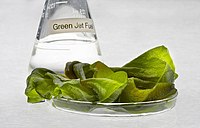
Photo from wikipedia
Rhodosporidium toruloides is a useful oleaginous yeast, but lipids production is affected by various factors including nutrients in the culture medium. Herein, the R-ZL2 high-yield mutant strain was used to… Click to show full abstract
Rhodosporidium toruloides is a useful oleaginous yeast, but lipids production is affected by various factors including nutrients in the culture medium. Herein, the R-ZL2 high-yield mutant strain was used to investigate the effects of different carbon sources (sucrose, glucose, xylose), nitrogen sources (ammonium sulphate, ammonium nitrate), and C/N ratio on lipids production capacity, get the following conclusion (1) Compared with glucose and xylose, sucrose was a superior carbon source for lipids production; (2) When using ammonium sulphate as the nitrogen source, a C/N ratio of 200:1 achieved the highest biomass, lipids production and lipids content (10.7 g/L, 6.32 g/L and 59%, respectively), and lipids produced under different C/N conditions have potential for biodiesel production (except for C/N = 40 and C/N = 80); (3) When using ammonium nitrate as the nitrogen source, a C/N ratio of 200:1 achieved the highest biomass, lipids production and lipids content (12.1 g/L, 8.25 g/L and 65%, respectively), and lipids produced under different C/N ratio conditions have potential for biodiesel production. Thus, a combination of sucrose and ammonium nitrate was optimal for the lipid accumulation in R-ZL2 . The findings will lay a foundation for further improving lipids yields.
Journal Title: AMB Express
Year Published: 2021
Link to full text (if available)
Share on Social Media: Sign Up to like & get
recommendations!